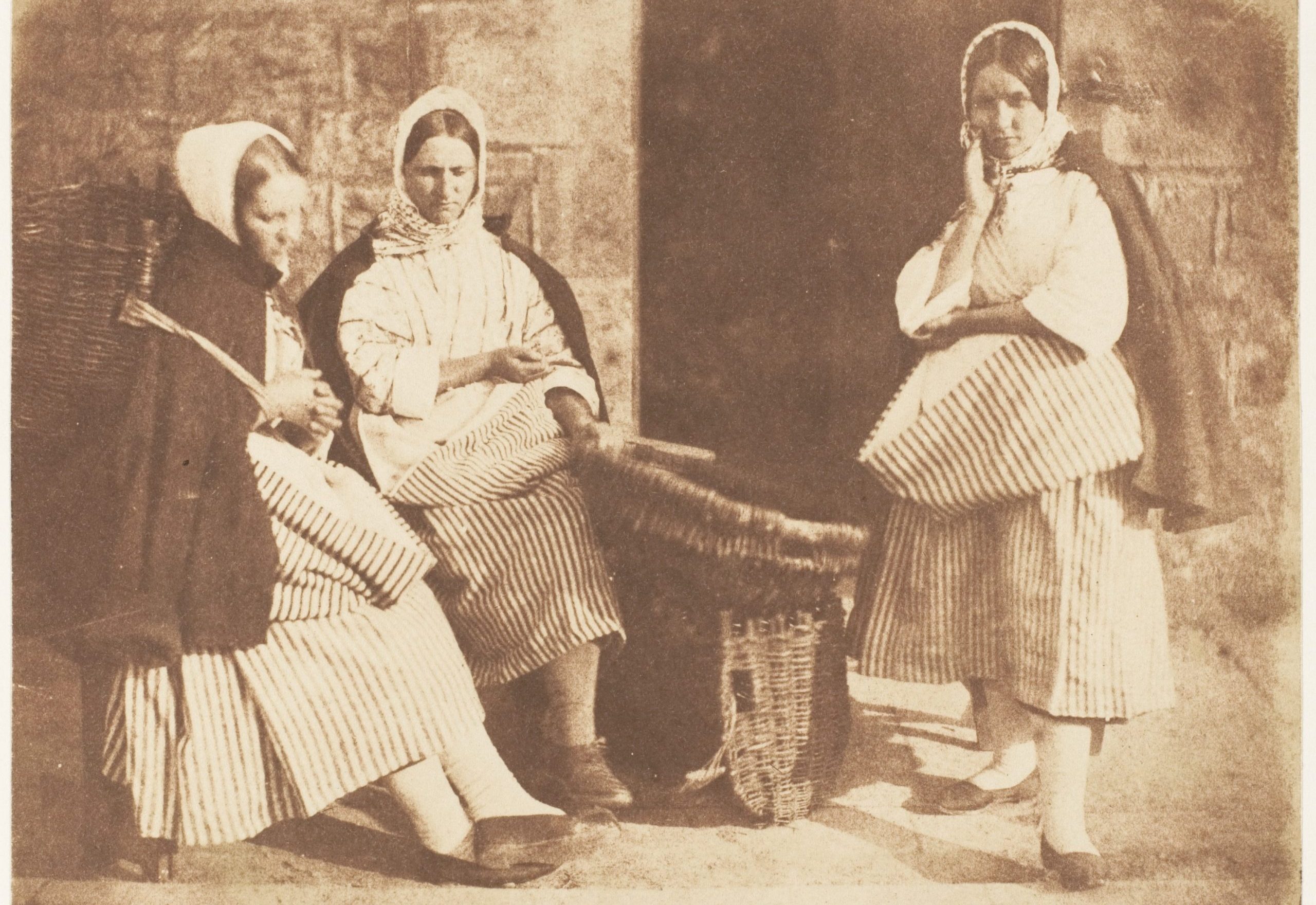Books & Culture
The Real Housewives of 16th-Century Scotland
Public spectacles of female conflict have long enforced social codes about male and female behavior

In Glasgow, Scotland, in 1574, two women landed in legal trouble for a wild public fight: Janet Dunlop threw dirt in Margaret Martin’s window where Margaret had set out her bread, cheese, and butter for sale. Margaret, who was clearly not a woman to be played with, responded to Janet’s spoiling of her wares by throwing urine at Janet.
URINE.
This was only one of the many public fights between married urban townswomen that took place in Scotland’s streets and marketplaces in the 16th and 17th centuries, according to legal records from Scottish town courts. Hair disheveled, cheeks bloody, and clothes askew, the undignified women described in these 500-year-old cases hurled scathing sexual insults at one another—insults based on rules for sexual behavior that were created by and benefit men . This scenario of female conflict put women in the role of policing one another’s sexuality, so that men did not have to do so, and it enabled men to serve as restorers of order and models of restraint; often they broke up fights or were cited by the court as responsible for ensuring that their wives behaved in the future. Historian Elizabeth Ewan has found that women in Scottish legal records were far more likely to attack other women than to assault men. These fights happened in public with plenty of witnesses, as evidenced by bystanders disagreeing in court over details like whether one woman had called another “drunken beast, vagabond, and bitch” or simply “vagabond and whore.” The resulting punishments were equally public, with perpetrators sentenced to issue public apologies that re-articulated their nasty insults for all to hear, walk bare legged through the marketplace, or spend hours locked in the town pillory for everyone to gawk and jeer at them. Jonet Brus, for example, had to apologize to Isabel Kerrington by declaring before the townspeople of St. Andrews, “I called you a common bloody whore and said that you cheated on your husband along with various other harmful words that were not true.” As I read through these legal cases of assault and defamation from 500 years ago, I found myself having a familiar reaction of appalled, scandalized, slightly embarrassing delight. It’s the same way I feel when I’m watching a fight between women unfold on one of Bravo’s Real Housewives franchises.
I found myself having a familiar reaction of appalled, scandalized, slightly embarrassing delight.
This parallel left me wondering: why am I—and I’m sure I’m not the only one—so entertained by narratives about women expressing their anger at one another? And where, exactly, is the line between entertaining stories about female conflict and cases of dangerous criminal violence?
The enormously popular Real Housewives shows—which have aired for the last fifteen years, currently exist in eight separate city-based franchises, and are the subject of a recent book by Brian Moylan—similarly center on public catfights between women. The crew of cameramen and producers exploit every boozy dinner and cast trip for maximum conflict. The housewives express their anger at one another through table-flipping, wineglass-smashing, drink-throwing, hair-pulling, and slinging insults such as “slut pig,” “beast,” “drunken fool,” and “a slut and a liar and a hypocrite and a snake” who “fuck[s] everyone.” Like the Scottish cases, these disputes often wind up in court: Joanna Krupa sued Brandi Glanville for claiming on television that her “pussy smelled” before the two women reached a settlement, and multiple physical altercations have led to assault charges. The network knows that viewers are hungry for these narratives: the women’s feuds are teased in each season’s premiere episode, drawn out throughout the season to build narrative suspense, and explode when the women confront each other about their grievances and are encouraged by producers to apologize at the season’s end. For example, at the 2014 reunion episode for the Real Housewives of Atlanta’s sixth season, Porsha Williams told her castmate Kenya Moore, “Your vagina is so rotten that no one will claim you.” Kenya accused Porsha of cheating on her ex-husband and called her a “dumb ho,” speaking into a megaphone that she’d brought with her to amplify her insult. Porsha responded by declaring, “You are a skank from the nineties” before rising to her feet and proclaiming, “I will fuck you up.” She seized Kenya by her hair, pulling her to the ground and dragging her across the stage—echoing the 1640 Aberdeen case in which a waterman’s wife named Helen Mearnes dragged Janet Walker by her hair and threw a wooden dish at her. Bravo network executive Andy Cohen, who had just grinned gleefully at Porsha’s “skank from the nineties” insult, leapt up and shouted “NO, NO, NO” as a group of other men materialized from off-camera to help him subdue and separate the women. Porsha was later arrested on assault charges.
Cohen’s mingled glee and horror at witnessing the women’s altercation exemplifies the irresistible electric charge of titillation, drama, and spectacle central to both the Scottish legal cases and the Real Housewives “catfights”: they are at once dramatic public events featuring actual, living women and highly constructed narratives framed and filtered by men who heard testimonies, gave verdicts, and wrote down every hair-pull and scathing insult word for word. What is more, the Housewives altercations occur between women who were once friends, or at least friendly colleagues for the sake of the show. This, too, reflects medieval interpersonal dynamics, like the case where Isabelle Squyer “laid hands violently” on Helen Gilham, whom Isabelle had previously chosen as godmother to her child, in 1495. These conflicts, even though they’re separated by five hundred years, point to a common cultural tendency to allow women to fight (even while having rules against it) as a way of enforcing social codes: women confront each other for allegedly sleeping with men who are not their husbands, for spreading scandalous rumors, for being financially dishonest. One sixteenth-century Scottish poem insists that women are “downright deceitful, fickle, ferocious, and frivolous,” and these nasty fights over sex, lying, and money appear to confirm those stereotypes while also turning their punishment—in the form of embarrassing, extremely specific apologies in the town marketplace or at a Bravo reunion show—into a spectacle that encourages onlookers to react with “voyeurism and judgment,” as Brian Moylan puts it.
I imagine how the men passing judgment on these cases in Scottish town courts must have been filled with delight and disgust.
The catfight narratives surviving in dusty old court record books are thrilling to read, filled with unexpected and vivid details—such as the fact that Isobel and Bessie Kyntray attacked Jonet Reid by striking her on the face with a raw fish in Elgin in 1545. I imagine how the men passing judgment on these cases in Scottish town courts must have been filled with delight and disgust, struggling to keep a straight face when witnesses to a 1539 fight in Aberdeen’s main street testified that Margaret Porter had attacked Janet Chesame by “calling her common vile friar’s whore, saying that she was one who has a large quantity of lice between your shoulders; I shall lead you to the place where the friar fucked you, where you undid the ends of your belt.” I imagine the male court reporter’s eyes widening as he wrote down that Elspeth Clogy landed in trouble for “throwing stones at Christian Sauchie and biting her through her arm and letting the piece of flesh that she bit fall into the water” in an altercation that also involved Elspeth’s sister and mother.
I’m aware that these scenarios are shaped by long standing stereotypes that women are naturally antagonistic toward one another and that this mutual antagonism requires male intervention and discipline to restore order, making the women seem like vicious, out-of-control catfighters while the men serve as patient, rational peacemakers. And yet, I still cackled when I read that a beer-brewer named Katherine Jack called her servant Elspeth Mukkart a “common whore and thief that has lain these last nine years in the devil’s arms with another wife’s husband both by night and day.” And I’m not the only one who’s viewed these narratives of women’s conflict as entertaining drama: in a play performed for a public audience in the summer of 1552, Scottish writer Sir David Lyndsay included a scene in which two married townswomen rushed to a tavern to confront an attractive young woman who is drinking with their husbands. They called her “whore” in all sorts of creative ways and threatened to beat her with their wool-spinning sticks, echoing numerous real-life cases in which women hit each other with those very same household tools.
Like Real Housewives episodes, Scottish legal cases are filled with women expressing their anger at one another through hair-pulling, drink-throwing, and colorful insults: Margaret Ogstone testified that Janet Mawer was drunk on the Sabbath when she called Margaret “base whore, drunkard, thief-faced bitch, English jade, vagabond, queane,” using as many synonyms for “whore” as possible. Janet filed counter-charges by claiming that Margaret had insulted her as “drunken jade.” In Elgin, Margaret Froster hit Christian Vardan on the head with a pan and pulled a large quantity of hair out of her head; Christian verbally attacked Margaret as a “vile mare” (a nasty sexual insult), “common whore,” and thief. In Inverness in 1566, two female ale-brewers teamed up for a vicious attack on a pregnant woman who was drinking in an alehouse that one of them owned with her husband. Jonet Sutherland testified that she was enjoying an innocent drink at John Morrison’s alehouse when John’s wife Elspeth Barnet and her friend Marion Ogilbe “cruelly set upon her and pulled her hair, scratched her face, called her common thief’s brat, and said that her mother broke into barns and lived on cheap mollusks brought out of the sea.” Jonet claimed that the assault nearly caused her to miscarry that night, and Marion’s husband was designated as responsible for answering further charges on his wife’s behalf if Jonet experienced pregnancy complications in the coming days. And in Elgin in 1550, Jonet Maitland was sentenced to one hour of public humiliation in the pillory “for the unlawful casting of a vessel full of ale in Isobel Douglas’s face and striking her on the head with the vessel and calling her injurious and vile words.” The altercation was mutual, as Isobel was sentenced to several hours in the town jail for hitting Jonet and attacking a local town official who intervened in the women’s fight insulting him as a “penniless villain” and “beggar peasant’s brat.” Throwing a drink at someone is still categorized as assault today, and it has become a mainstay in countless Real Housewives conflicts. It humiliates the target by leaving her drenched and sticky, her hair flattened and makeup streaming down her face.
It humiliates the target by leaving her drenched and sticky, her hair flattened and makeup streaming down her face.
One particular altercation on the Real Housewives of Potomac’s latest season drew headlines because it involved vicious hair-pulling, wine-flinging, and mutually-filed criminal charges. In this conflict between two former friends, which occurred while the ladies sampled wine and cheese at a Maryland winery, Candiace Dillard-Basset and Monique Samuels continued a long-running verbal dispute from previous episodes, stemming partly from a nasty rumor that Monique’s baby son had been fathered by her personal trainer instead of her husband. Candiace taunted Monique while waving a small cheese knife. Another cast member removed it from her hand, a particularly prudent move given the fact that Candiace had threatened a castmate with a butter knife in the previous season. After Candiace repeatedly invited Monique to “drag” her, Monique finally reached across the table and seized Candiace’s wig, refusing to release her. A large white platter of cherry tomatoes slid helplessly off the table between them, ranch dressing spattering across the floor. Monique beat Candiace on the head with her left hand, her right steadfastly gripping Candiace’s hair, as a horde of previously off-scene male producers and security guards swarmed in to separate the women.
This crowd of men, who materialize on screen to impose order every time a reality television conflict between women escalates from words to physical force, is significant. Typically these men remain out of sight, but the women’s turn to physical violence—which diverges from the expected war of words that characterizes many a Housewife gathering, especially when alcohol is involved—forces the show’s gendered mediating powers to make themselves visible, reminding us that these incidents of women’s anger at one another, from Scottish streets to contemporary television sets, are both real, spontaneous expressions of rage and highly-manipulated scenes that serve particular purposes.
Both women filed criminal charges of second-degree assault after the incident, which were later dismissed after a judge determined that the altercation was “mutually consented.” The show used the fight and its aftermath, along with Monique and Candiace’s subsequent deliberations about whether to file charges, as the basis for the whole fifth season, rendering it at once a criminally violent conflict and a dramatic entertainment storyline to draw viewers and boost ratings. At the reunion marking the season’s end, Bravo executive producer Andy Cohen encouraged Monique to apologize to Candiace, serving a similar function to the Scottish town officials who sentenced women to apologize publicly to one another for their public displays of rage in addition to suffering humiliation, imprisonment, and fines.
When I first saw the fight between Candiace and Monique, I was filled with scandalized delight. Perhaps I should not admit this, but watching it unfold on television, almost a year after I read about the criminal charges in the news, was everything I dreamed it would be and more. Even though I, as a Black feminist, am intellectually aware of the pervasive cultural misogyny that shapes these types of representations, and I am also vulnerable to being viewed as an angry, out-of-control Black woman myself, I cannot deny the exhilaration I felt when the wine flew through the air, when the raw broccoli florets scattered across the floor, when all the men with earpieces rushed out from behind the scenes. While the Real Housewives shows and the Scottish legal cases were not created for the same purpose—since the former are produced for entertainment, while the latter are records of wrongdoing and punishment—they’re both “all about conflict and conflict resolution,” to quote Brian Moylan, about entertainment as well as empathy. Moylan says that Real Housewives fights give us “the thrill of vicariously doing something we want to but can’t,” and I do often find myself identifying with the motivations for the violence that the women commit against one another, even if I would never actually pull a ponytail or throw a punch: there is a perverse and shameful satisfaction in seeing Monique finally accept Candiace’s invitation to drag her after Candiace taunts and twirls in front of her, in seeing Porsha rise up and seize Kenya by the hair after Kenya has spent the whole episode obnoxiously shouting insults at everyone through her personal megaphone, in reading about Margaret Ralston hitting Agnes Allen and maliciously scattering the leeks that she was selling in the Glasgow marketplace after Agnes shoved her
I do often find myself identifying with the motivations for the violence that the women commit against one another.
In other words, these public spectacles of conflict, both then and now, do more than simply enforce social codes about female behavior; they also saddle onlookers with the messy feeling of gawking judgmentally at public misconduct at the same time that we identify with the players enacting it and the sentiments underlying it. Any diehard Real Housewives fan roots for some Housewives, even in spite of their bad behavior, and despises others; similarly, onlookers who witnessed the Scottish fights and their punishments had complicated allegiances to the women involved in them as neighbors, relatives, co-workers, or marketplace rivals. This brings me back to sixteenth-century Glasgow, where Margaret Brown terrorized her fellow townswomen over the course of several years. She shoved Margaret Craig and scratched her mouth and nose, shedding her blood. She attacked Jonet Law by striking her, pulling her hair, throwing her to the ground, and tearing her clothes. She hit Margaret Rossie’s small child, who was being held by a servant. A few years later, Margaret herself was the victim: Jonet Barde had to pay six shillings and publicly ask Margaret’s forgiveness for throwing stones at her, pulling her hair, and striking her, causing her to bleed. When Jonet voiced her public apology and listed specifically how she had wronged Margaret, the townswomen of Glasgow likely had a range of reactions: I’m sure some of them listened with horror, judgment, or disapproval. And I have no doubt that others, given Margaret’s long record of aggression against her peers, listened with scandalized delight, sympathizing all too well with Jonet’s actions even if they would not have been quite so vicious themselves.








